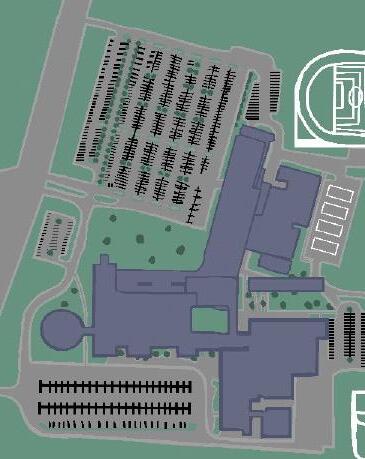Staff
On behalf of the Pilot staff, We have heard countless concerns over the safety of the new building. Time and time again it has been brought to our attention that the the lack of communication between student and admin over the safety of the new building has been troubling to members of the student body. It is our intention that we bridge the gap in communication and answer your pressing questions and concerns by talking with the most reliable sources and direct influences. We have provided as much information as we can on this topic in regards to community safety. Additionally, if you feel that we have left out vital information that may help you feel more safe at Lindbergh, we encourage you to use the QR code on the back cover. This space is provided to address any lingering concerns you may have, and please leave your email if you’d like a response.
-Elowyn Wells Editor-in-Cheif











 Editor-in-Chief Elowyn Wells
Copy-Editor Elizabeth Cleary
Indesign-Editor Van
Staff Writer Lavia Roaf
Staff Writer Lindsey Pham
Staff Writer Meadow Roy
Staff Writer Audrey Branding
Staff Writer Gavin Berry
Staff Writer Sam Elliott
Staff Writer Savannah Millheim
Video Producer Joey Haberberger
Staff Writer Kyra Bast
Editor-in-Chief Elowyn Wells
Copy-Editor Elizabeth Cleary
Indesign-Editor Van
Staff Writer Lavia Roaf
Staff Writer Lindsey Pham
Staff Writer Meadow Roy
Staff Writer Audrey Branding
Staff Writer Gavin Berry
Staff Writer Sam Elliott
Staff Writer Savannah Millheim
Video Producer Joey Haberberger
Staff Writer Kyra Bast
Table of Contents
Meadow Roy - Infographic (11)
Elizabeth Cleary - News (10)
Sam Eliott - News (7)
Natalie Van - Infographic (12 & 13)
Gavin Berry - News (8 & 9)

Lavia Raof - Feature (16 & 17)
Savanah Millheim - Infographic/News (4 & 5)




Audrey Branding - News (6)
Kyra Bast and Elowyn Wells - News (18 & 19)
Lindsey (14 & 15)
Do You Know What To do?
Information on drills at Lindbergh High School from Dr. Brown
Savannah Millheim | Staff Writer
Safety drills. Natural disaster drills. These are common practices in high school’s these days, but why are they so important? Drills are in place to make sure people know exactly what to do when there is any sort of emergency. Where to go, who to talk to and what to do are all questions people might have should an emergency happen. With that in mind, Lindbergh prioritizes students’ safety. The district just hired a new director of safety, Randy Gimerson. Part of Gimerson’s role is to meet with Assistant Principal Dr. Brown to discuss safety drills and if they can be improved to maximize safety within the school district.
“Anytime we find a new way to keep people safe we will use it because safety is a priority at Lindbergh,” said Dr. Jason Brown (assistant principal). According to Brown, these meetings will result in updates to safety drills and procedures for students and staff, but Dr. Brown shared information about the district’s current emergency policies.
What Drills do Lindbergh have in place?
Dr. Brown said Lindbergh currently has three different types of safety drills for students. The first: Evacuation. Evacuation is where staff and students should find the safest way out of the building when necessary. The second: tabletop drills. Tabletop drills focus on what students and staff can do within the classroom, examples being intruder (lockdown) and earthquake drills. The last of the drills would be a combination of the two in which students might need to leave the classroom, but stay in the school.
Why is it important to practice drills?
“You always go back to what you’re trained how to do,” said Dr. Brown, emphasizing the importance of practicing safety drills. When put in a stressful situation, the brain triggers a physiological response: flight or fight. Practicing what to do when there is an emergency helps the brain stay calm when deciding what to do and what the best course of action may be in an emergency.
“Some might say you either rise to the occasion or fall to your level of training,” Dr. Brown said.
Practicing these drills ensures students know exactly where to go, who to talk to, and what to do during specific situations. The staff hopes that students can be confident in knowing what to do should an emergency happen.
What can students do to better educate themselves on Lindbergh’s Drills?
“A good place to start is to ask a teacher,” said Dr. Brown.
Making sure you know what route to take during an evacuation drill for every class, and even an extra is something Dr. Brown is highly encouraged. However, English Department Chair, Matthew Griner pointed out the fear of emergency situations can have a profound impact on students' mental health.
“Student safety is important to me because we have a responsibility to care for our students and provide a safe learning environment for them. Sometimes that means protecting them from common typical dangers like fires, and weather-related things. But also from potential harm, you know mental health issues.”
Matthew Griner (English Department).
It is important that everyone in the school has a plan in every class for a tabletop drill like a lockdown or earthquake. Using all resources in the classroom ranging from desks and chairs to window blinds can make a huge difference during an emergency.
4 News 04.21.23
What to do in Case of Emergency
Advice From Dr. Brown
The Three Types of Drills
-Evacuation: Get out
-Tabletop: Stay in
-The combonation: Leave the class to relocate somewhere safer if it is close


Fire

-Follow your teachers directions
-Let your teacher know who you are and that your safe
Intruder
-Depending on where the intruder is make the best decision
-When near you: Lock down (lock door, remaine silent, stay away from windows, barricade door)
-When far: Evacuate
Tornado/Earthquake
-Move to lower levels
-Stay away from windows
-Get to a storm shelter (The gymnasiums) IF it is close. If not ask your teacher

!
5 Infographic 04.21.23
Taking Attendance
The Protocol of the Lindbergh High School Attendance Office
Audrey Branding | Staff Writer
On any typical day, someone arrives at the attendance office, they ring the bell and the ladies at the office usually ask who they are or why they are visiting the building . The question is raised, however, about how trustworthy people really are during these more recent times.
When students arrive late, all of the doors are locked and other students in the building are not allowed to let people in. The only way for students to access the building is through the attendance office. Laura Ratliff (Attendance office) is one of the staff members that works in the attendance office. She said there are specific procedures in place to allow students into the building. , “The students have to be Lindbergh students, they have to check in with the security guard when they arrive and then when we unlock the doors, they have to go directly to us,” Ratliff said.
Those protocols are not just for students. Main Principal, Dr. Cochran said all visitors are expected to check into the building through the attendance office. “Mostly, we require all visitors to check in at the attendance office. The primary expectation is that they have to have a reason to be here or a person to visit that knows they are coming. If they are not here for a legitimate purpose, we can turn them away,” Cochran said.
Visitors are also expected to be outfitted with a special pass.
“We do have a system that runs a visitor’s driver’s license. It is designed to notify us if there is a concern that should potentially keep someone off of a school campus. The system then prints out a visitor’s pass that verifies for all of us that this individual should be in the building,” he said.
At least one student had opposing thoughts on how the attendance office handles letting people in. “Knowing that the attendance office sometimes lets people in without strict verification makes me feel uncertain about our true safety at this school,” Sydney O’Brien (12) said.
Despite those concerns, the school does have policies put in place to keep students safe and secure.
6 News 04.21.23 Infographic courtesy: Alexandra Yocum
Would You Feel Safe Evacuating Down Those Stairs?
Sam Elliott | Web-Editor
With a new building and continued construction comes the discussion of safety for both students and staff. Many students have expressed their concern for the safety of the stairs from the very beginning. Beyond the complaints of general travel between classes, some worry it would be unsafe during an emergency evacuation.
The new building contains three floors and three sets of stairs, which are separated throughout the three corners of the school. With these new stairs also comes new concerns. A lot of people feel the stairs are already crowded, and in the case of an emergency where all the students are rushing down the stairs at once, not many people are hopeful in the event of a real evacuation scenario.
“Well, yeah, it would be chaos. It’s hard enough getting down those stairs normally,” Jordan Datus (11) said.
The students aren’t the only ones with concerns about the staircases, though. Some of the teachers have their own concerns as well, such as history teacher, Mrs.Weitzel, who is one of many teachers on the third floor of this new building. “My greatest concern is for disabled students, like, I wouldn’t know what to do in that situation,” Weitzel said.
This poses a good question, and it turns out, there is already a solution in place for this very issue. On some of the stairs there are “Evac Chairs.” The chair has a simple yet very helpful use. Noticeably by its large yellow bag, it displays an example of its usage.
“Evac Chairs (Evacuation Chairs) are a universal evacuation solution for a smooth stairwell descent during an emergency. Designed to evacuate the disabled, elderly, pregnant, children, injured, blind, Epileptic, or the mobility impaired.” A helpful guide provided by California State University Dominguez Hills explains step by step how to use these simple devices:

7 News 04.21.23
Stop the Prop
Stop the Prop
Don’t Prop Me Now Stop the Prop, What is it? How do we prevent Break-Ins?
 Gavin Berry | Staff Writer
Gavin Berry | Staff Writer
With the continued construction of a new building, Lindbergh has continued to keep its students safe. However, in the process, a major problem administrators are facing is how well students are able to maintain that safety. Specifically, intruders possibly entering the school which could lead to some issues resulting in injuries.
Stop the Prop is a solution that has appeared to keep the buildings and students secure and safe. A large aspect of the problem is the awareness of said movement from both staff and, mainly, students.
“When someone’s locked out, our first inclination is to let them in because, as human beings, we like to assume most of the time that most people are good.”
In order to raise awareness, staff have placed stickers labeled “Stop-the-Prop” on the doors of the buildings at the beginning of the year with the intention that students won’t open doors for any outside visitors. But why students let unauthorized people through entrances such as the auditorium gate is still up in the air.
Timothy Lombardo (LHS Sociology Teacher)
“Because of that, they don’t necessarily see the potential consequences as a threat to them or their school,” Sarah Saunders (LHS Psychology Teacher) said.
“I think some students are probably familiar with Stop the Prop, but I bet there is a lot that don’t know,” said Eric Cochran (LHS Principal).
A leading factor contributing to unauthorized access entering schools has been the mentality of the students. Construction plays an essential part, as students view a locked out person, unknowingly, as part of the Lindbergh community. Without full confirmation, LHS students will let them in through a wrong
8 News 04.21.23
entrance rather than letting the intruder go through the attendance office located at the auditorium.
But students may not see the full picture of letting an intruder in the school. As school break-in numbers increase, so does the amount of shootings. Such organizations like EducationWeek have also stated, “There were 51 school shootings in 2022 that resulted in injuries or deaths.” A possible solution, if an unfortunate event were to happen, could be the practice of live action school shootings, a precaution that allows for a drill that tests students and staff depending on the intruder’s




S Sururvveey R y Reessululttss::
Are you familiar with what Stop the Prop is?
location.
“What we try to do with our drills is we try to do a scaled down version, where we give information but we allow students to recognize that there are choices that they get to make within that drill with the information they have,” Cochran said.
With both the construction of the new building and students’ trusting behavior, the chances of a possible intruder increase unless Stop-the-Prop becomes a no longer needed campaign as providing protection for both staff and students is crucial in avoiding possible break-in scenarios.
Have you held the door open for a student or staff member to let them in the Lindbergh Campus?
Have you made attempts to direct students toward the attendance office instead of holding the door?
If you have been locked out, how did you enter?
I still think people are unsure of who is and who isn’t supposed to be here.
-Kevin Lombardo News 04.21.23
“ “
9
Assess the exits Safely evacuate Check in with a teacher/adult

Safety Drills: How Well Do You Know Them?
An insight into Lindbergh’s staff and students’ thoughts on safety drills
Elizabeth Cleary Copy-Editor
Safety drills have always been a hot topic issue in schools. Everyone has a different opinion on how they should be taught and executed and to what extent. Within LIndbergh High School, many students and staff hold their own viewpoints on what Lindbergh does well and what it can improve on in regards to these drills.
In a recent schoolwide, student survey, many of the respondents expressed concerns about their understanding of the safety drills at Lindbergh. A common theme among students was anxiety regarding the amount of information they receive about the drills. Many respondents felt that the drills are not discussed thoroughly, with only 13.5% of those respondents claiming that all seven teachers have gone over intruder drills with their class. Furthermore, only 27.8% of those students that responded have said that all seven teachers have gone over fire drill procedures and only 14.8% have had seven teachers go over tornado procedures.
“I think that there needs to be more discussion instead of practice, as I could not name the meetup points nor the evacuation routes but do know to walk in a single file line. We need to know the logistics before we can perform a safe evacuation,” one respondee mentioned in the anonymous survey.
Another respondent commented, “I feel like there could be more alternatives and directions given. In the event an intrusion takes place, I think students will be very panicked and under prepared.”
Carena Heilich-Henry, a teacher at Lindbergh, is an advocate for the importance of safety. During her time at Lindbergh, she said she has attended many training days during which she has been taught the different procedures for the drills.

Heilich-Henry explained that, in order to prepare for emergency situations, teachers are required to watch safety videos at the beginning of the year. There are questions following the videos that they must answer and then submit, helping to inform Lindbergh staff and troubleshoot any areas of confusion.
“I will say, when problems arise or we see flaws in our current plan and system and we see inefficiencies, there is a team of teachers that come together usually… in order to solve those problems or to make things
better,” Heilich-Henry commented.
This year, Lindbergh staff was provided with a slideshow in order to ensure that the drills were being taught consistently to students. However, even with that slideshow, it is ultimately up to the individual teacher to decide how indepth to talk about safety drills.
“A lot of times it is just encouraged, I would say, that you can talk about as much or as little as you want with your students as long as you do something,” said Heilich-Henry.
Courtney Klohmann, a teacher in the science department, has a slightly more complicated situation in that she does not have a fixed classroom.
“They told us to go through the safety procedures in all of our classrooms; because I’m a traveling teacher, I have three classrooms, so I have to know the different safety procedures for three different rooms,” Klohmann commented. That being said, Lindbergh works to stay open and honest with its students about drills, keeping students and staff aware that in a real drill, there would be a multitude of options and pathways to choose from.
“They (Lindbergh) did a good job at teaching us that in a realistic situation, there is no set pattern that you can just automatically go to, you have to base what you do on the situation. So you have to analyze a situation and then react based on what’s happening,” Klohmann said.
While both Klohmann and Heilich-Henry note that there are improvements that need to be made and more consistency in how often the subject is talked about, they also acknowledge that Lindbergh provides resources that ensure safety, creating a secure environment for both students and staff.
“I think knowledge is power, I think high schoolers are old enough to understand the situation. I don’t think you should go into detail necessarily with an elementary kid… but high schoolers, I think, they would feel empowered with more information,” Heilich-Henry said.
“I think knowledge is power...”
~Carena Heilich-Henry~
In case of a fire drill: 10 News 04.21.23
Infographics courtesy: Anna Soeder
Student Familiarity with the Safety Drills at LHS
I feel like there could be more alternatives and directions given. In the event an intrusion takes place, I think students will be very panicked and under prepared. ~ Respondee to a Student Survey ~



Percentage of Teachers that have Explained Procudures for School Safety Drills




Students’ Thoughts
Q: Does Lindbergh rehearse fire drills often enough?

A: “Yes, at least once per semester would be enough to remind students of the procedure.” ~ Alexander Carron ~
A: “I think it would be worthwhile to do a few more, since I’m not fully aware what the plan would be for every one of my classes.” ~ Julian DeWeese ~

A: “Yeah, fires are extremely uncommon in schools so one drill every so often is fine.” ~ John Mendoza ~

Intruder Fire Tornado
Intruder Tornado Fire
(Unfamiliar) (Familiar)
HOURS
“
” 11 Infographic 04.21.23
Timeline of School Tragedies Nationwide
April 20, 1999
1: Columbine High School Massacre
June 13, 2008
2: Cedar Rapids Community School Flooding
April 10, 2010
3: Calexico High School Earthquake
In 1999, two students at Columbine High School in Littleton, Colorado killed 12 classmates and one teacher before taking their own lives. The incident sparked a national debate on gun control and school security, leading to the implementation of new security measures in many school districts.

In 2008, severe flooding in Cedar Rapids, Iowa caused extensive damage to over 20 schools in the Cedar Rapids Community School District. The floodwaters caused damage to classrooms, libraries, and equipment, resulting in temporary school closures and disruptions to the education of thousands of students.

How Lindbergh Takes Action...
In 2010, a 7.2 magnitude earthquake near the US-Mexico border caused severe damage to buildings, including Calexico High School in California. The school suffered structural damage, disrupting the learning of the students and forcing the school to close for several weeks.

Lindbergh School District takes the safety of its students very seriously, especially in light of the recent shootings in the St. Louis area. To ensure the highest level of security, the school has implemented various measures, including having multiple law enforcement officers patrolling the building at all times, detailed intruder drill plans, and resources to better school security protocols. Additionally, the school equips its doors with “Stop the prop” signs to help prevent unauthorized entry. Lindbergh’s comprehensive approach empowers students and staff to respond effectively to potential threats, with options for fight, flight, or stay in place. By prioritizing student safety, Lindbergh is taking proactive steps to create a secure learning environment for its students.
Infographic 04.21.23
12
May 22, 2011
November 8, 2018
December 14, 2012
October 24, 2022
1
The 2011 Joplin High School tornado was a deadly and devastating event that showcased the destructive power of tornadoes on schools. With over 2,000 students, Joplin High School suffered significant damage, forcing students and staff to relocate while repairs were carried out. Tornadoes remain making emergency preparedness and effective disaster response plans critical for ensuring the safety and well-being of students and staff.

The 2018 fire that destroyed Paradise High School in California was caused by dry weather, strong winds, and damaged power lines. The fire quickly spread, causing destruction and forcing students and staff to flee without their belongings.

In 2012, Adam Lanza killed 20 children and six adults at Sandy Hook Elementary School in Newtown, Connecticut. The incident sparked a national debate on gun control, with calls for stricter laws, including expanded background checks and limits on certain guns. the implementation of new security measures in many school districts.


In 2022, A tragic mass shooting occurred at Central Visual and Performing Arts High School in St. Louis, Missouri, which left three people dead and seven injured. The incident has raised questions on how to protect students and faculty, and the school has since implemented increased security measures
With Lindbergh High School being located in Missouri, which is in the Tornado Alley. To ensure safety, Lindbergh practices tornado drills twice a year and has thorough emergency weather procedures. Additionally, Lindbergh promotes safety by practicing earthquake drills twice a year. Lindbergh also practices fire drills monthly to make sure students and staff members are aware of what to do if a real fire were to affect the school. Lindbergh always shares the steps of what to do during a fire and always has fire extinguishers all across the Lindbergh High School community.
4: Joplin High School Tornado
5: Paradise High School Fire
6: Sandy Hook Massacre
Infographic 04.21.23
7: CVPA High School Massacre
13
LINDBERGH HIGH SCHOOLS OLD BUILDING LAYOUT

LIBRARY
POOL CAFE
GYM 3 MAIN BUILDING GYM 2 LINDBERGH BLVD AUDITORIUM LOBBY + HALLWAY 400s PAST MATH BUILDING 300s 300s TENNIS COURT FIELD FIELD
CAFE
COMMONS
GREEN GYM
LINDBERGH HIGH SCHOOLS NEW BUILDING LAYOUT


Now that the buildings are combined a bigger, more spacious parking lot is now built.
The 2 buildings will be connected. Including the pool and the Weight lifting room.
The old library will soon be converted into a Future Gifted Center.
MAIN BUILDING
MAIN BUILDING
COMMONS


FIELD FIELD
TENNISCOURT
GYM
CAFE CAFE
3
MAIN BUILDING GYM 2 POOL WEIGHTROOMLIFTING
GREEN
GYM
Student Perspective
LaviaRaof|StaffWriter



Q: How do you feel about the conduction of drills at Lindbergh?
Elliot Mikesch (10)
A: “ I definitely think there’s a need for more intruder drills. Just the day and age right now, we just need more of them to prevent things that would happen or could happen at Lindbergh.”
Vivian Le (10)
A: “ I feel like especially for the tornado drill, no one knew what they were doing. I was in the new 300’s and everyone went to the black box, but there was no space left so we had to continue going. The stairs we went through also had multiple windows, that’s really unsafe. I feel like we have a good amount of drills though, because we’ve been doing these since kindergarten so realistically we know what we’re doing but it’s a different environment every year.”
Q: What do you think about national events regarding student safety? How do you think that affects students here at Lindbergh?
Elliot Mikesch (10)
A: “I think a lot of students today are afraid to come to school– there’s definitely a level of fear. I know me personally, I was fearful some days and I know a lot of my peers are too.”
Vivian Le (10)
A: “I feel like especially with school shootings and things like that, it makes people a lot more worried and scared, especially with how last year there was a school shooting in the St. Louis area.”

Admin Perspective
Eric Cochran (Main Principal)
Q: How do you feel about the construction of the new building?
A: “Oh I’m really excited about the construction of the new building. It’s been an adventure but we’re making significant progress and anticipating by the start of next year, we will have almost everything wrapped up.”
Q: How do you feel about the protection in the new building versus the old?
A: “ The biggest difference when it comes to safety is that this building is a building that you do not have to go outside (of). For most of my career here at Lindbergh we had multiple buildings and on any given day we had 80 exterior doors that had to be left open so kids could get from one building to another to get to their classes. So, with the new building that is no longer going to be the case and we will be able to everybody stay inside of a secure, locked down building. All the doors will be locked during the day and so that’ll be a significant difference and was really one of the major reasons why we built the building in the first place.”
Q: How has the conduction of drills changed at Lindbergh?
A: “We historically had a regular schedule of drills. I would say COVID knocked that off a little bit; drills usually require that you gather in certain places with lots of people and COVID made that harder to do, so we did a lot more of theoretical drills where we were just talking through what we would do in a situation instead of actually doing it. And so we’re trying to transition back to doing those regular drills where you’re actually physically getting up, leaving the classroom or doing something inside the classroom.”
Tricia Hays( LHS Counselor)
Q: How do you feel about the construction of the new building?
A: “Construction hasn’t been too bad, I think it’s made things a little bit crazy– I do feel like it has limited how people can get from the different buildings, so I feel like things have been a little bit more congested at times. The ultimate result is going to be a good thing.”
Q: How do you feel about the protection in the new building versus the old?
A: “I do feel like it’s going to be better. I used to be an elementary school teacher, so when I came here I went from being in a completely locked building to this building where doors were open and all of these other buildings. That was a little scary. So I am excited about us being under one roof, in one building, no one having to travel in between buildings. I think safety wise, it is set up for one entrance in, one entrance out during the school day which I think will be beneficial. They’ve taken measures to the glass, it’s equipped to prevent certain things from happening.”
Q: Do you think the drills at Lindbergh should happen more often? Less often? And what types of drills do you think should be prioritized?
A: “Basically we’re supposed to have fire drills once a month– which I think is still a good idea to practice. But I think those could maybe be a couple of times a semester, I personally think we could probably do intruder drills more and make them more realistic and a little bit different every time to get different experiences.”
Q: What do you think about national events regarding student safety? How do you think that affects students here at Lindbergh?
A: “I do think that it makes students nervous and that’s totally understandable. I do worry that there are students who “copycat”. We need to make sure that we’re educating everyone– honestly kids and adults– of what it really means if you’re going to make a threat and the ramifications of that.”
Meet the Minds
What are they saying about SAFETY DESIGN?


“I would say your school is one of the safest designed, engineered, and built schools with respect to the physical and electronic hardware... probably one of the safest schools in the country based on how it was built and designed from.”
“Once fully completed, the new high school will be one of the safest buildings in the region, from many different potential threats such as fire, earthquake, tornado, and intruders thanks to the latest technology and design innovations in the market today.”
“I would say that our building is state of the art. There are things incorporated into the design and things being added that are heads and shoulders above where anywhere else you’ll be, so as far as safety goes, I would say that yours will be one of the safest in the area.”

“ “
Phil Santore Safety Consultant
Steven Schrage Product Manager
Scott Barbagallo Director of Facilities
19 04.21.23 News
New Building Design is based in Personal Experience and Person First Mentality
Elowyn Wells and Kyra Bast | Editor and Chief and Staff Writer
Influences on New Design
The new building for Lindbergh has been a project that has taken the skill of many different fields in order to create a safe environment that promotes learning. Through the work of Introba, BSI Constructors, and Lindbergh staff, the redesigned school has been acclaimed to be one of the safest in the country, according to the project managers.
“I have three girls who were in middle school and high school when Sandy Hook happened, which was about fifteen miles from my house. So, school security is near and dear to my heart for a lot of reasons, not to mention it was literally in my backyard, so to speak.” Phil Santore has stated where his desire to design safe, comfortable, and effective buildings came from. In order to preserve this “educational mission,” he has detailed what criteria must be followed to make this possible.
“We kind of live with what we call the D’s: Deter, delay, dispatch, and we hope we never get to the last one which is defend,” Santore detailed, “when we talk about attack it’s about life safety, we don’t care what happens, we don’t care how damaged the building is, it’s all about people.”
Santore mentioned how he and the rest of the team working on the new building designed it with one goal in mindproviding students a safe and productive learning environment.
“Young folks are the future of who I once was, what my kids will be, and you and your kids will be,” Santore said. “If we mess up that mission, then we really all fail as consultants and architects and design engineers and all of those things.”
Safety Implimentation
When asked about how security has been integrated into our school, Santore referenced the work he had done on Sandy Hook.
“If you were to walk through Sandy Hook school, and even your school, you’re only gonna see about 50% of what’s in place in Lindbergh.”
Steven Schrage gave his input into how the high school is prioritizing safety in the new building.
“When fully completed, the high school will have secure entrances and students will be able to travel to every classroom and activity space within the secure building.”

Phill Santore described the ideas that safety consultants keep when designing security measures in any building.
“If we just think about it in simplistic terms, it’s about securing your building, knowing who’s coming into your building, knowing that you can secure and monitor it, knowing that you can call for help, and then creating areas and processes for things when they happen, so when something happens, just like when the fire alarm goes off, everybody has fire drills, we know what to do.”
When asked how they would assure the students of Lindbergh on the safety of the new building, Santore said, “Your school is one of the safest designed, engineered, and built schools with respect to the physical and electronic hardware.” Scott Barbagallo commented, “Nobody really had a school building that looked like this.”












 Editor-in-Chief Elowyn Wells
Copy-Editor Elizabeth Cleary
Indesign-Editor Van
Staff Writer Lavia Roaf
Staff Writer Lindsey Pham
Staff Writer Meadow Roy
Staff Writer Audrey Branding
Staff Writer Gavin Berry
Staff Writer Sam Elliott
Staff Writer Savannah Millheim
Video Producer Joey Haberberger
Staff Writer Kyra Bast
Editor-in-Chief Elowyn Wells
Copy-Editor Elizabeth Cleary
Indesign-Editor Van
Staff Writer Lavia Roaf
Staff Writer Lindsey Pham
Staff Writer Meadow Roy
Staff Writer Audrey Branding
Staff Writer Gavin Berry
Staff Writer Sam Elliott
Staff Writer Savannah Millheim
Video Producer Joey Haberberger
Staff Writer Kyra Bast











 Gavin Berry | Staff Writer
Gavin Berry | Staff Writer




































